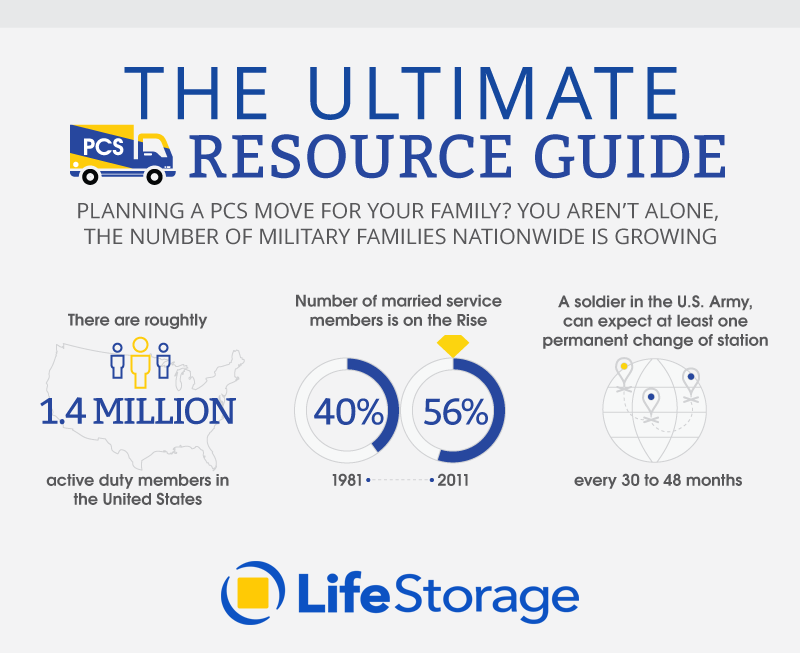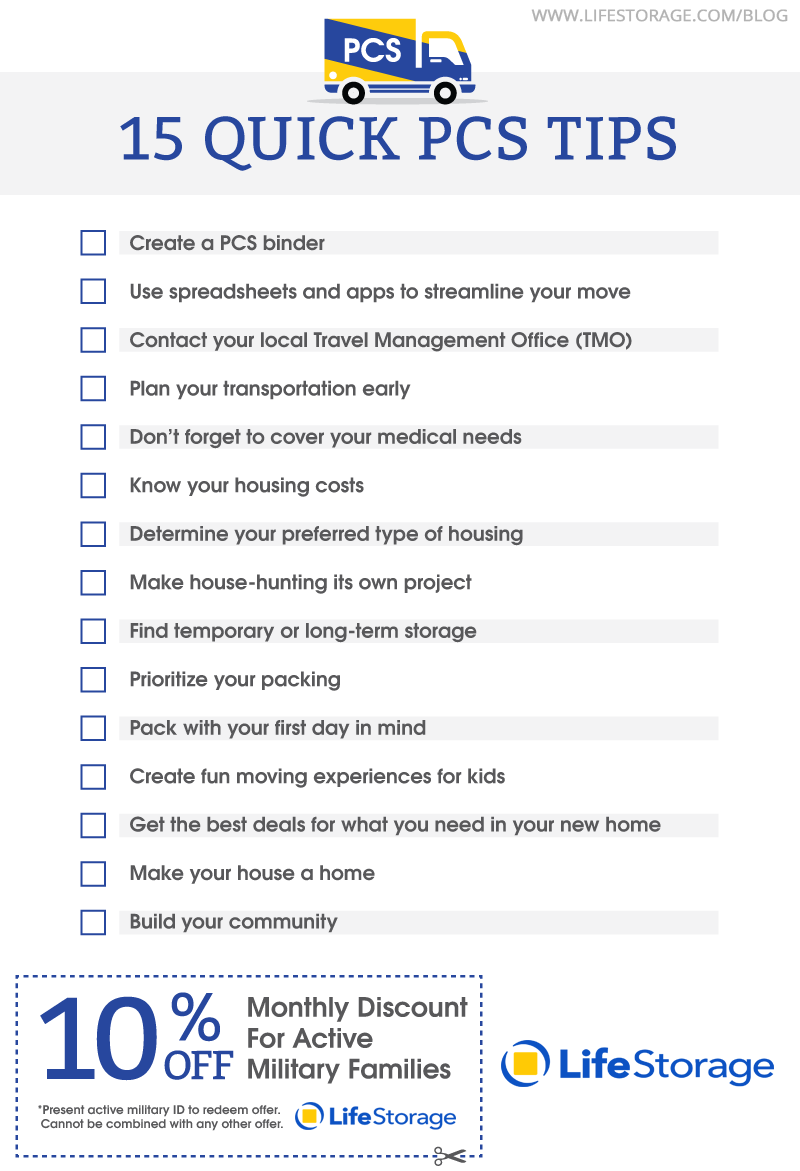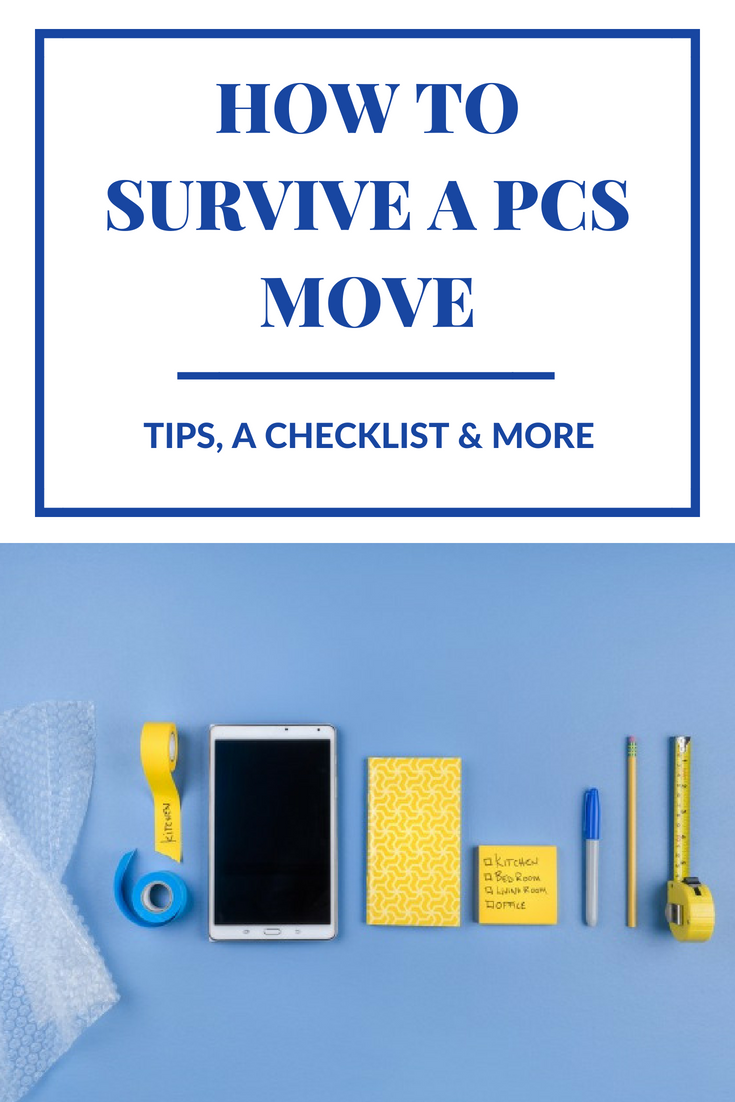
Moving always comes with a set of challenges, from buying or renting a new home and packing up your old one to enrolling the kids in a new school and perhaps even finding a new job. For most of us, moving isn’t a regular occurrence — according to the United States Census Bureau, Americans move an average of 11.7 times over the course of their lives, with the frequency decreasing as we get older. That’s not necessarily the case for military service members. For those who serve, a military PCS (permanent change of station) is inevitable; a U.S. soldier can expect at least one station change every two and a half years. Not only that, but a military move presents its own unique difficulties.
There are significantly more logistics involved in a military move than in a non-military move — you’ll have more paperwork to process, and it requires a different packing strategy since you’ll be loading and unloading at a new, often completely unfamiliar destination. That’s why it’s so important for military families to stay organized. That’s where this helpful PCS move checklist comes in. It incorporates military relocation tips from those who know — family members just like you who’ve completed a PCS move (or, likely, several PCS moves) and have plenty of military moving hacks to share. We also answer some common questions that may come up as your prep for your move.
What should be in a PCS binder?
A PCS binder is a collection of your vital documents. You can choose to put everything in it, including personal records such as birth and marriage certificates, or just your military-related and, if you’re heading overseas, travel documents. You can also include our free PCS checklist. At the very least, it should have everything that you need to make your move as stress-free as possible, so you don’t need to rifle through boxes for paperwork.
Do I pack my own boxes for a military move?
Military movers will typically pack up your current home, so you can pretty much leave everything as is unless the company has given you instructions otherwise. You may want to hang onto irreplaceable valuables and pack bags for you and your family members that contain anything you need upon arrival, such as clothing.
Will the military move my furniture?
Yes, furniture is usually taken by the moving company. To make sure everything arrives at your destination, you may want to prep a PCS packing list so the movers know exactly what they should be taking.
What will military movers not take?
It’s best to check with the moving company, but there are certain items that military moves will not take, such as houseplants, batteries, and ammunition. They may also require you to disassemble some things before they can move them.

Step 1: Organize your move by creating a PCS Checklist binder

You or your military spouse has just received notice — you’re on the move. You might be relocating within the continental U.S., or you could be heading overseas. Either way, an organizational strategy will be key to keeping your sanity intact through the lengthy process. To keep paperwork in order, create a PCS checklist binder.
Essentials to include in a PCS checklist binder:
- Passports
- Personal documents
- Medical records
- Insurance documents
- Marriage license
- Car titles
- Contacts for both the current and upcoming duty stations
- Housing applications
- Old housing clearance
- Bill termination notices
- Household inventory
- Reservations for travel
- Any other paperwork that must be accounted for during every phase of the move
With this PCS checklist binder that includes every bit of crucial transition information always accessible, your military family is prepared for a smooth PCS move.
Step 2: Save free printable PCS checklists
Of course, if creating a PCS checklist from scratch seems daunting, you can use templates others have created, such as these spreadsheets from Megan from The Homes I Have Made, for all your moving needs. They work best if you print the sheets in a paper file or are certain you will have laptop or tablet access on the road.
Step 3: Plan your transportation
If your PCS move is overseas, what will you do for a car once you arrive? According to many seasoned military families, it makes sense to ship your car, because the military will pay!
Many military families will ship one vehicle and then buy or lease a less expensive “short-term” car that they can get rid of at the end of their time at that location. If your PCS move is in the U.S., you can still look at shipping a car if you don’t want to put on the wear and tear involved in driving across the country.
Related: How to Ship a Car Easily and Affordably
Step 4: Look for military airline discounts
As with most purchases, doing some research can help save you money. JD at A Semi-delicate Balance has compiled a list of airlines that offer military discounts.
Often, military discounts aren’t included in an airline’s advertised rates, but the booking agents on the phone will help. Usually, the discounts can also apply to dependents or even military retirees. One word of caution, though — still shop around because a military airfare discount still might not be the best deal.
Step 5: Plan for medical assistance along the way
Tara is a military spouse with a little girl and two energetic puppies. This Aiming High Wife and military mom recommends keeping a list (even if it’s mental and not on paper) of the hospitals’ locations along your travel route. You’ll want access to immediate medical care if you need it, especially if you’re pregnant or have small children. When traveling through or around major cities, there should be plenty of resources if one of your kids gets sick along the way. However, pediatric care could be harder to find if you’re traveling through less densely-populated areas. Knowing ahead of time where to go can save a lot of stress if something happens along the road.
Step 6: Find temporary or long-term storage
If you’re not moving directly into a new home, you may need storage for furniture or household items during the “gap” between permanent residences. Or, if your move is to somewhere with a vastly different climate from where you’ve been, you might have clothes or other items that you want to keep but that aren’t going to be worn or used during your stay.
- Search Storage Units Near You
- How to Find Storage Unit Deals
- Choose the Right Storage Unit Size for Your Needs


Step 7: Learn about cost reimbursement and unforeseen expenses
If you own a home, you could incur a loss when you sell if the market is not profitable where you live. Research the seller’s market to see if you should set aside extra funds that would help if you end up losing money on the sale of your house. If you’re currently renting, having an apartment or house professionally cleaned could cost several hundreds of dollars, so doing it yourself may help save some money. Just be sure to do a good job so that you receive back your complete security deposit.
Additionally, there are a lot of household supplies and food that might end up getting thrown out as you prepare to leave. Most moving companies won’t move liquids or food, so minimize purchases of household goods in the months before you move. You’ll need to do a full restock of food, cleaning products, and possibly some personal hygiene products when you arrive, all of this can take a toll on your budget.
The military should reimburse you for time spent in temporary housing at a new duty station, but the up-front cost will be out-of-pocket. You need to have cash savings on hand to cover these costs until your reimbursement arrives.
Step 8: Determine your preferred type of housing
When you’re embarking on a PCS relocation, there are several options for finding a home, each with its pros and cons.
- Private military installation housing. In this situation, a service member and family can receive basic housing allowance and live in a private home where rent is paid to a manager or owner who functions as a property manager in the civilian community.
- Government-owned military installation housing. Sometimes, especially overseas, government housing is the only solution. This is owned and maintained by the Department of Defense, and the family wouldn’t pay rent or utilities but also won’t receive a housing allowance.
- Single military installation housing. This is also called “unaccompanied” housing, which is an option when the service member is single or a married service member is separated from the family and living alone. Often, these take the form of barracks or dormitory-style living, which could mean a single or shared room or private room with a shared living area. In this case, too, there is no housing allowance, but there is also no paying rent or utilities.
- Rent a home off-installation. If you choose to live off the installation, you could rent a home or apartment that you find yourself. In this case, you handle the specifics of your lease, utilities, maintenance, and other responsibilities, which can add to the stress of moving. The military has specific legal protection if service members must break a lease when deployed or transferred.
- Buy a home off-installation. Of course, buying a home is a huge commitment and investment. The biggest consideration is what you will do if you are reassigned or deployed. Would you put your house on the market immediately? Is the area likely to be a good seller’s market? Would you look for a tenant if you can’t sell immediately? Can you afford to maintain the one home and buy or rent another in your new location? These are all questions that you must ask if you’re contemplating buying a home near your installation.
Step 9: Reach out to resources like the Defense Travel Management Office (DTMO)
The DTMO is prepared for things you might not have considered. It will provide you with a military move checklist that must be completed. For example, if you’re headed overseas, there will be mandatory health checks for the whole family. But DTMO can help with transportation planning and other logistics, even if you intend on a DIY or PPM (personally procured move). Many other services, like the Automated Housing Referral Network (AHRN), offer resources like PCS move checklists, rent comparisons, school information, and other factors based on your specific criteria. Use the AHRN in a way that will most closely benefit you and your needs.
Step 10: If you’re buying, get pre-qualified for a mortgage before you shop
It’s always easier to shop for a home if you’re pre-qualified for a mortgage, especially if you need the process to go smoothly and quickly. The first step, though, is to check your credit score. The interest rate you ultimately get on your mortgage will likely depend on a combination of your credit score and the amount of your down payment.
Robin McDaniel is one of the experts behind Everything Finance, and she advises making a list of “needs, must-haves and wants.” You might see a house that just sings to you… but still consider whether it’s truly the right purchase. It could be a wonderful house, but in a neighborhood where your children won’t have any playmates. If that’s important to you, then you might need to look further.
Step 11: Make a separate house-hunting binder
You might have the most complete military moving checklist ever, but consider that house-hunting requires its own file and system of organization. When searching for a house, even if a lot of the research is online, there will be listing sheets, brochures, application forms, and more that you’ll need as you shop.
If you’re making a special trip to your destination for a few days of intensive house-hunting, you will want a separate moving binder to keep your papers, contacts, and other information in order. Having a moving binder that’s separate from your PCS checklist binder will help you keep all of your most important paperwork organized – and keep you sane.


Step 12: Prioritize packing if moving with children
Even if this isn’t your first PCS move, your priorities might be different this time from the last. For instance, if you’re moving with children for the first time, think about what that means for packing. Make sure that all of the baby gear is on the truck first. With PCS moves, the first truck could fill up, and the second truck might not arrive for another month. It’s important to prioritize packing the essential nursery and children’s items so they are included in the first arrival.
Step 13: Plan a do-it-yourself move if it makes sense
It is possible to have a do-it-yourself PCS move—just ask JG, a military wife, who has done it four times as part of her Me and My Soldier Man lifestyle! She, her husband, and their baby daughter are experienced with moving, and she gives the following advice:
- Figure out how many boxes you need before you start to gather supplies.
- Pack decorative items with little practical use early to get them out of the way.
- Label boxes clearly and with more detail than you think you need.
- Have a garage sale to get rid of anything that you don’t need to bring. This is great for kids’ items that they’ve outgrown or no longer use. “Hippy Milspouse” Kara has tips for getting rid of stuff you don’t need (aka “a guide for hoarders”). She loves it because she has left her home in Vermont for deployment in Korea.
- Even if you’ve packed on your own, hiring help to load the truck can be a huge help.
Step 14: Select your unaccompanied baggage for overseas military moves
If you have an upcoming PCS move overseas, you can take 1,000 pounds of unaccompanied baggage by air, which means those items will arrive first. You might have to wait for the rest. So, think carefully about how you choose those 1,000 pounds of necessities. Jess, at Jessica Lynn Writes, is an Air Force wife, mom to two girls, and calls herself a “globetrotter.” Her unaccompanied baggage includes everything from bathroom mats to DVDs.
Step 15: Pack with your first day in mind
Things will be frantic when you arrive. Regardless of how organized you are, you need to anticipate a little chaos on the first day or two. One of our favorite tips is to have a “first-day box” that is well-stocked with things like batteries, electronics chargers, night lights, tools, and other move-in essentials.
Step 16: Color-code for easy unpacking
One mom says her favorite trick for a PCS move is to use duct tape in bright colors to mark every box and piece of furniture. She codes by room (kitchen, each child’s bedroom, playroom, etc.). When she arrives, she places a piece of the corresponding tape on each door jamb so that the movers know exactly where to place each item. Then, when she unpacks in her new home, everything is already in their new room and easily accessible.


Step 17: Create fun times moving with kids
Yes, really! Anyone who has moved with kids will tell you how exhausting it is. However, Military Spouse contributor Stacy Huisman is full of advice for preparing your kids and for the actual trip. She says:
- Make the trip an adventure. There are travel apps, car games, treat bags, snacks, movies, and other ways to keep your children occupied on the road or plane.
- Find “fun” hotels. A hotel with included breakfast and an indoor pool is key. The pool will give your kids a much-needed opportunity to blow off some steam after a long day of being cooped up in a car or plane.
- Keep kids on their normal sleep and eating schedules as much as possible. Kids take a while to adjust to changes, which can be hard, especially if traveling across time zones. But, if you can keep their naps, routines, and meal times consistent, it might help to keep them happy and things under control.
Step 18: Pack a little extra for the kids
Want to make a road trip with kids more fun? Worried about nutrition on the road? Prepare travel-friendly healthy meals in advance so your kids aren’t eating fast food along the way (well, maybe not for every meal, anyway).


Step 19: Get the best deals on what you need in your new home
Phew. Done. You’ve found a home, moved, and unpacked. Now what? First things first. You likely need to do at least a little restocking or supplement your supplies a little for the new digs. Before making any purchases, seek out retailers that offer military discounts.
Step 20: Use your dislocation allowance
You might be eligible for a dislocation allowance if you have been ordered to move into military housing or if you were evacuated from a duty station. Kate Horrell, a military finance coach, says that you might be eligible for government reimbursement for some of your moving or new housing costs.
Step 21: Make your temporary house feel like home

Sometimes it can be difficult to make military houses feel like home. Take some time after the move to create a welcoming environment, which will help alleviate some stress. Display your favorite family photos, invest in some cozy home decor, and get creative with blank walls.
Step 22: Build your community
This might be the most important of all of the military relocation tips out there. You might not think that your new home is ideal for your family, but keeping a positive attitude makes a big difference. Military communities are some of the easiest places to make friends because everyone starts as an outsider. From moms who have experienced a PCS move several times:
- Ask for help. Military communities are very giving when it comes to time and resources. Don’t be afraid to ask for what you need, whether it’s childcare or even just companionship.
- Be a joiner. Even if big events aren’t your thing, attend parties or events so that you can make a few solid friendships. Or, invite new friends to your home for a pizza party or playdate so that you can establish connections.
- Keep on top of your long-distance friends and family. It’s natural to miss those you left behind, but you can stay connected through technology. Apps like Skype and FaceTime allow you to celebrate occasions like birthdays or holidays together across the miles.
Step 23: Use our Printable PCS Checklist
If all else fails, we have a printable PCS checklist for you to use while planning.

A PCS move involves so many moving parts that we’re sure you have tips to share. We’d love to hear your strategies for making an easy move with your military family on social media via @lifestorage. Share with fellow military parents and spouses in your community so that we can learn from them, too. If there’s one thing we know about military families, you love to help each other out.
Updated 6/13/23 & 7/9/18 from a post originally published 2/18/16.
Save this Guide for Later:









